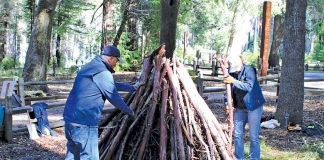
If I wanted to know how people of the Holocene period lived, what they ate, what they wore and what their houses were like, all I would have to do is look around.
Dear “Holocenians,” welcome to your period, named for the past 10,000 years of geological development.
However, some scientists disagree. Some believe that we are living, not in a new period, but in a continuance of the Pleistocene Epoch (which many hold stretched from 5 million to 1.8 million years ago) also known as the Great Ice Age, when there were intervals of glacial retreat.
Doesn’t feel like an ice age?
An ice age has many fluctuations in temperature over thousands of years.
Although Yosemite has no glaciers today, it was only 100 years ago that John Muir was skidding down ice sheets while the railroad was taking summer tourists from Santa Cruz to Big Trees Resort — now Henry Cowell Redwoods State Park.
Geological processes can trick us. Did you know that the river rocks at Cowell are from the Sierras? Were they brought here by glaciers, faults, or something else? Geologist Frank Perry says faults.
“Every rock has a story to tell,” says Frank, who has spent his life deciphering their messages. “A rock is one-stop shopping for a geologist.”
Frank was born and raised in Santa Cruz and has a degree in earth sciences from University of California, Santa Cruz. He recently co-authored the book, “Lime Kiln Legacies,” on the history of the lime industry in Santa Cruz County. (Those of you who joined Judy Hill and me for the Fall Creek nature hike will remember seeing the overgrown lime kiln there.)
Frank will soon lead a geological walk through the San Lorenzo River streambed at Henry Cowell. We will become amateur rock hounds, and he will share the inner histories of the stones we find.
We will also break open rocks and may find fossils, clams and snails, from 15 million years ago. Frank has a special interest in paleontology and has written several publications on local fossils.
Diane Ackerman wrote in her best-seller, “A Natural History of the Senses,” that “Sometimes one finds in fossil stones, the imprint of a leaf, long since disintegrated, whose outlines remind us how detailed, vibrant and alive are the things of this earth that perish.”
Taking the river walk to Eagle Creek, we will explore the origins and geological history of the granite outcroppings.
If you have not been to the convergence of the creek and the San Lorenzo River recently, you might be surprised how Eagle Creek bullies its way down the hill, even in this drought.
The river is at its summertime low, and when I was there most recently, the sun bounced off the alluvial deposits, creating a rich brassy-yellow hue. Kids splashed and yelled in the mild water while their parents sat in the middle of the river, legs dangling off small boulders as they read.
In the shadows of the west bank, a mother mallard hustled her two surviving ducklings to safety. Our halcyon moment was the steam engine railroad from Roaring Camp whistling its way over the bridge.
As I walked back, a large sycamore leaf fell on my head like a hat and reminded me that in only a few weeks, these groves will have a head full of shimmering gold.
If you would like to join Frank and me on our geology walk Aug. 15, please contact me for more information.
This is a free walk sponsored by the Valley Women’s Club and made possible through a grant from the San Lorenzo Valley Water District.
Carol Carson has been a docent for Henry Cowell Redwoods State Park and has taught courses on Big Basin State Park for UCSC Extension. She volunteers as an environmental educator for the Valley Women’s Club and can be contacted at ca****@*********on.com.










